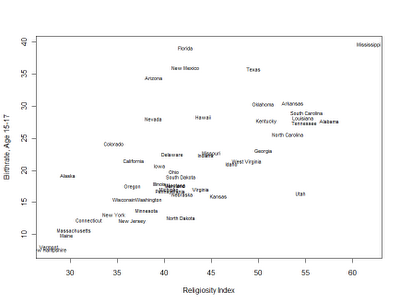|
Friday, October 02, 2009
A few weeks ago I pointed to a paper which suggested a state-level relationship between teen births and religiosity. I did the calculation, and added in race as a control, as well as breaking out birthrate of the 15-17 age bracket. My results differ a little because 1) I didn't impute states like Rhode Island, 2) I think I used 2000 Census household income numbers, not later American Community Survey numbers (my bad).
Race didn't make that big of a difference. Here's a map with the states:  Click it for the big version. But Utah is an outlier now because its 15-17 teen birthrate is way lower than when you include 18-19. The social reason for this is obvious; young marriage among Mormon women. I'm skeptical of the conclusions or at least the explanatory framework in the model in the paper. I will do an analysis of Hispanics, as there's something there. The states well above the trendline have large Hispanic populations, and Hispanics aren't that much more religious than whites (so they would push a state in the vertical direction, but not to the right). But I think if I can get county level data I might see some interesting correlation with Scotch-Irish ancestry. Some of the states with high teen birthrates, like Oklahoma, have a higher proportion of Non-Hispanic whites than nationally, so there's some other story to be told here. Addendum: I suspect that a lot of the time when it come to religion and social data the causality is inverted. Both the anti and pro-religious tend to take the efficacy of religion for granted (though their value judgments would be inverted). But in many cases it may be that particular religious "styles" (e.g., low church vs. high church) reflect the state of a given society. There is a body of social science data which shows the strong relationship between socioeconomic status and particular Protestant denominations, and the strongly biased "switching" of those who move up or down the socioeconomic ladder in their lifetimes. A similar effect might be at work on the aggregate social level. Labels: data |
||||||||||||||||||||||||||||||||||||



